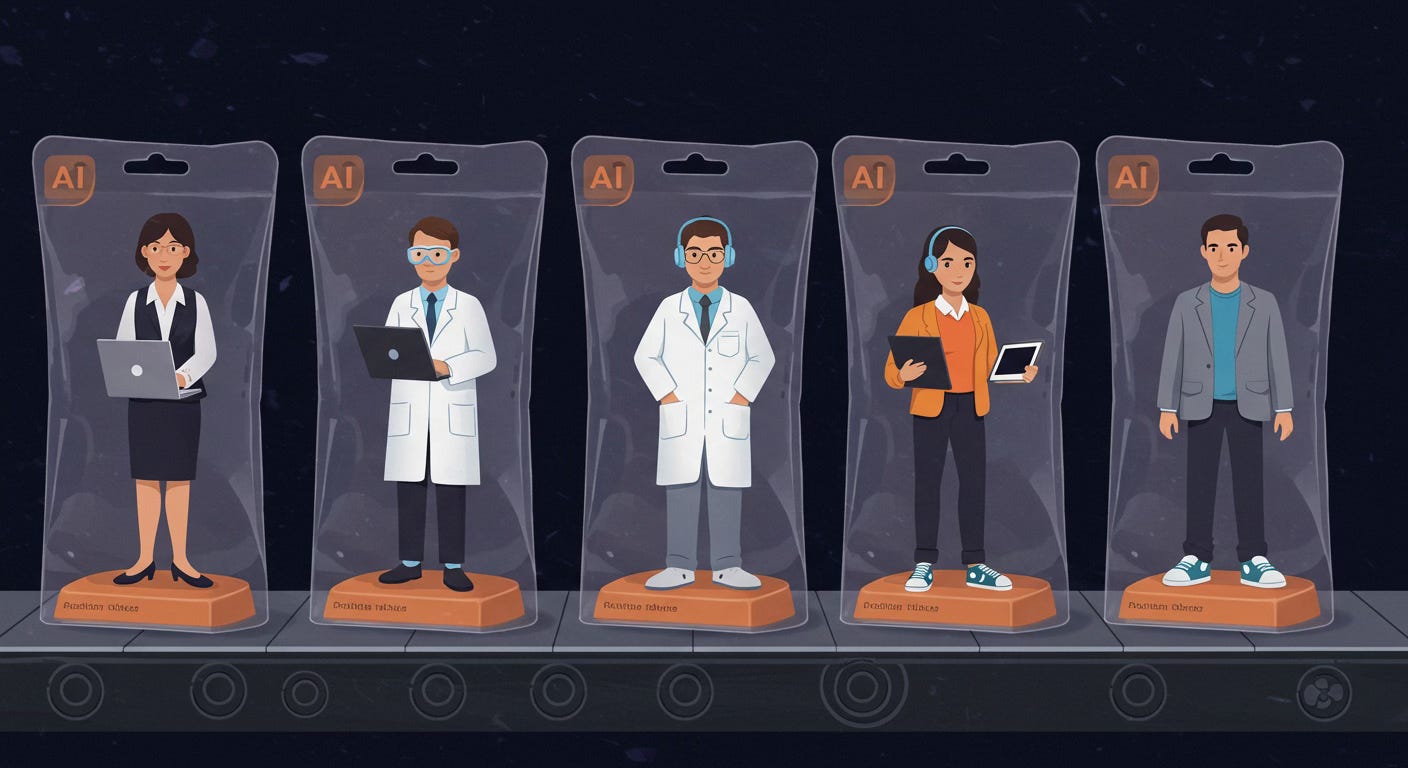The outrage over AI’s energy use is the real waste ⚡️
The meme panic is blinding us to what AI might actually solve
The internet’s latest existential crisis? Action figure selfies.
Ever since OpenAI’s new imaging tool dropped, people have been turning themselves into Barbie-boxed avatars and posting them everywhere.
It’s fun, fast, and apparently, fatal for the planet.

Then came the BBC warning: ChatGPT could be guzzling more electricity than 117 countries combined. Cue panic.
Climate experts are lining up to question whether viral content is worth the carbon. “Every time we create one of these AI memes,” one tech editor joked, “it kills a tree.”
But this panic is getting it backwards.
Yes, AI uses serious power. But the more important question is what that energy is starting to deliver, and what we risk by holding it back.
At every major event I’ve covered this spring (from Sustainability Week and the Energy Transition Summit, to the Business Innovation Summit and Fusion Fest) the message from engineers, researchers, and policy leads has been surprisingly consistent: yes, AI is hungry. But the concerns are misdirected.
AI might be the tool that helps solve the energy crisis. It’s already pointing in that direction. It’ll optimise grids. Predict failures. Compress timelines. Rewrite the rules of scientific discovery.
If anything, we should be accelerating the right kinds of AI, not slowing them down. The footprint is real, but so is the future it could open up. And it’s a big one.
If you’re worried about AI’s energy bill, fine, but ask what you’re getting for the cost. Because unlike almost anything else in the system right now, AI has the potential to pay it back with interest. Let me break it down… 👇🏻
Millennial Masters is brought to you by Jolt ⚡️ The UK’s top web hosting service
Burning power, building progress
AI’s energy use is being criticised by the very people it’s most likely to help.
From the outside, it looks like a contradiction: we’re trying to build a greener world, yet we’re fuelling it with tech that chews through electricity and water like there’s no tomorrow.
And the numbers aren’t small. Microsoft’s emissions rose by a third. Google’s went up by half. In some data centres, water usage is already triggering shortages in communities.
At the Business Innovation Summit, Tikiri Wanduragala from Lenovo didn’t sugar-coat it: “This power story… we’ve known this problem for a long, long time. But what AI has done is put it on steroids.”
Data centres are scaling 3x, 5x, even 10x, and infrastructure is struggling to keep up. Cooling systems, grid access, power redundancy… suddenly, “very boring” problems are board-level crises.
But here’s what almost nobody’s saying out loud: the same tech that’s fuelling the spike is also the thing that might fix it.
Lenovo’s already using AI to cut waste in packaging and optimise logistics chains. Microsoft is running physics-informed AI to simulate fusion materials, replacing months of lab time with models that learn how atoms behave. And in climate tech, DeepMind’s AlphaFold saved “a billion years of alternative research” by cracking protein folding.
Yes, AI is energy-hungry. But it’s also obsessed with efficiency and finding ways to cut power use across the system.
AI is being judged as if it’s final, when it’s still evolving. This is still the messy, energy-intensive beginning of something far bigger.

No meltdown, just upgrades
AI is putting serious pressure on the grid. And the more we scale it, the harder that strain hits.
Philip Meier from L.E.K. Consulting laid it out at the Energy Transition Summit: data centre energy use could grow “three to six times over the next 10 years.” That’s not a rounding error, but a full-blown energy crisis in the making.
And yet, nobody in the room seemed panicked. Why? Because this is a problem with solutions.
Max Beverton-Palmer from NVIDIA reminded us that semiconductors have improved “100,000 times in energy efficiency over the last 10 years.” Not 10%. Not 2x. One hundred thousand times. We’ve seen this movie before: power demand spikes, innovation catches up.
Lucy Yu, CEO of the Centre for Net Zero, pointed to the real bottleneck: bureaucracy. “The challenge isn’t about the supply to power these data centres,” she said. “It’s around regulation, permitting, and speed of grid connections.”
Fix the system, and AI can actually help the grid. Smart data centres can soak up surplus solar, stabilise frequency, and even boost resilience in blackout-prone regions. Co-locate them next to wind or nuclear and you solve two problems at once.
Advanced nuclear players like Newcleo are already moving in. “There’s a perfect synergy between data centres and nuclear,” said Andrew Murdoch. They both want low-cost, reliable power. They both need tight grid connections. And in a world where AI workloads are only going up, pairing them makes economic and engineering sense.
As Yu put it: “Realistically, we’re unlikely to see new nuclear sooner than a 10-year time horizon.” In the meantime, renewables need to bridge the gap. Dynamic pricing, demand-side flexibility, and smarter grids could help carry the load.
We already know where the bottlenecks are. Now the question is whether we’re willing to fix them.
From memes to megawatts
The irony is that the tech criticised for guzzling power is now helping us figure out how to generate far more of it.
That’s the view from Fusion Fest, where researchers, founders and futurists made one thing clear: AI isn’t just powering memes, it’s powering breakthroughs.
Kenji Takeda from Microsoft Research didn’t hold back. “We’re really excited about the possibilities for artificial intelligence to accelerate fusion to the grid.” From simulating plasma behaviour to spotting materials nobody’s thought of before, AI is tackling the kind of physics that used to take supercomputers and full research teams.
This is where things get wild. Shruti Rajurkar described how Microsoft’s AI systems take a list of desired material properties: strength, temperature resistance, conductivity, and generate potential atomic structures to match. Like ChatGPT, but for fusion fuel.
Forget images. We’re now asking AI to invent entire molecules that could survive inside a nuclear reaction.
ITER, the world’s largest fusion project, is already deploying AI to speed up everything from code safety to workflow fixes, even building a digital twin of the entire reactor system.
The logic is simple. Fusion requires extraordinary precision. AI spots the failure points, runs the simulations, learns from noise, and uncovers options human engineers would miss. And it does it faster than any team alive.
This matters, not only because of what fusion could power, but because of how much time it could save. Every delay pushes clean power further away. Every bottleneck in material science, in engineering, in modelling, keeps us stuck.
With AI in the loop, we’re speeding up simulations and accelerating science itself.
That meme might burn a few kilowatts. But if it helps bring fusion a decade closer, it’s a bargain worth making.

Missing the real AI payoff
Yes, AI is burning through electricity. Yes, its footprint is growing. But let’s be honest: so is the internet’s. So is your fridge. So is the world.
What critics miss is this: AI is already starting to return value on the energy it consumes.
From optimising logistics to decoding fusion, it’s being put to work solving the exact energy problems it’s accused of causing. It’s not a perfect trade (yet!) but it’s a bet with upside.
Fusion is the best example. Think about it: if AI shortens the timeline to commercial fusion by even five years, that’s not just an environmental gain. It’s an economic supercharger. The same goes for AI models that cut waste, manage grids, or unlock new climate tech.
So no, AI shouldn’t get a free pass. But the backlash misses the point.
The better question is whether we’re using AI’s energy appetite to drive outcomes that actually matter.
The challenge ahead is coordination. Smarter datacentres. Tighter supply chains. Better incentives. More joined-up regulation. That’s how we ensure AI fuels the future, not just eats it.
Because in five years, we’ll look back at this debate the way we look at Y2K: part panic, part misunderstanding, and mostly a distraction from the real work.


